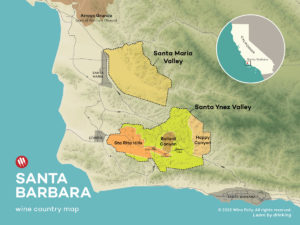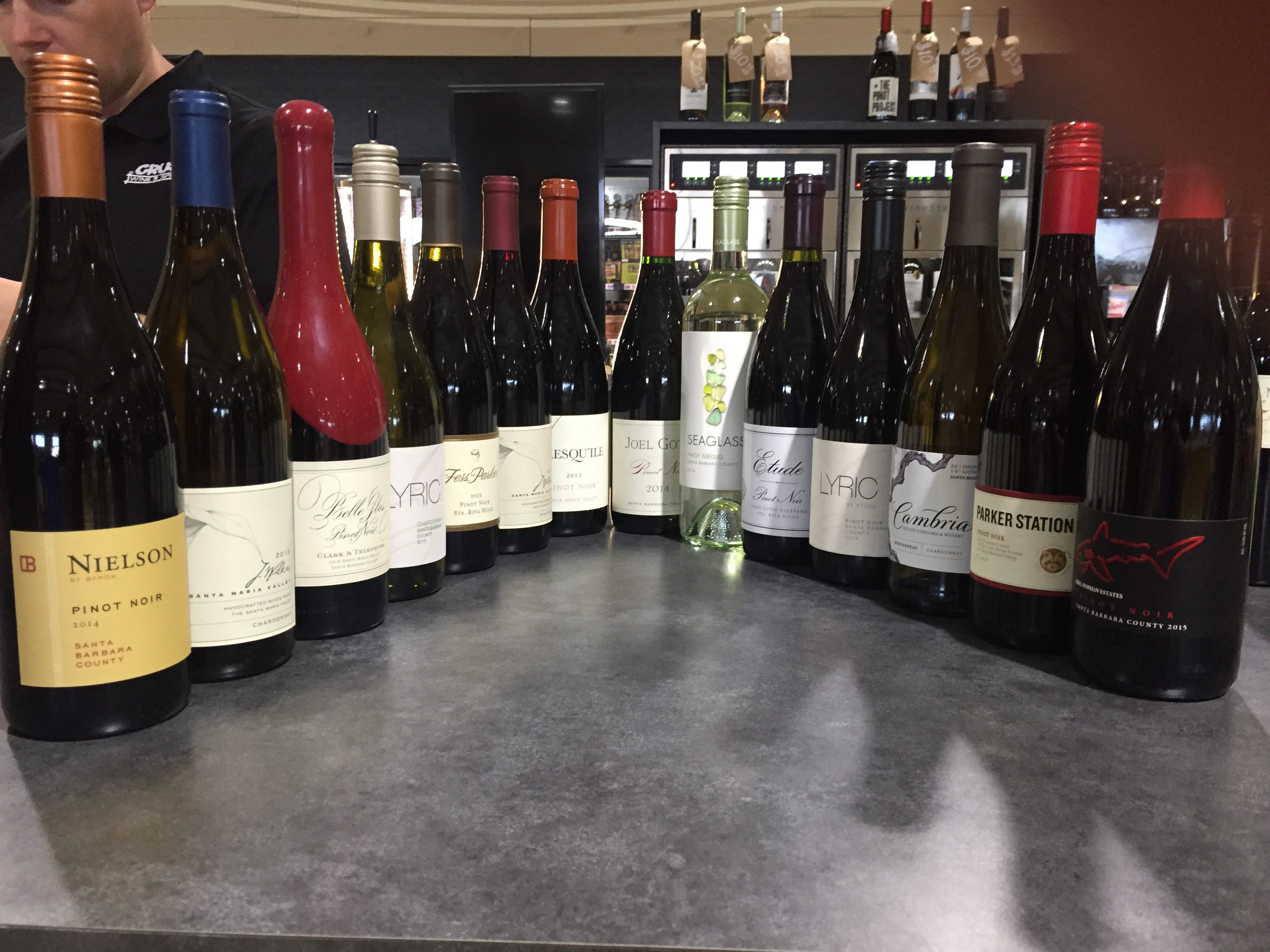Santa Barbara County is a fascinating wine region. Its vineyards are the furthest south of California’s Central Coast, yet it is a cool-climate region where winemakers have made some of the most respectable Pinot Noir and Chardonnay wines in the world. While the winemakers in places like the Russian River Valley, Los Carneros, Anderson Valley, Monterey County, and Willamette Valley had been making quality cool-climate wines throughout the second half of the 20th century, Santa Barbara didn’t reach its stride until the 1990s. And it wasn’t until the 2004 release of the movie, Sideways, that the general public became aware of all that Santa Barbara had to offer. The “Sideways Effect” contributed to the increase in sales and tourism to the region. In addition, the region continues to develop a diverse selection of wines. Full-bodied and ripe wines made from Bordeaux and Rhone Valley grapes also are now produced.
Santa Barbara County was a bloomer in developing its reputation as a cool-climate wine region. Although the first vineyards were planted back in 1786 peaking to 260 acres and close to 20 winemakers by the late 19th century, none of them survived Prohibition. The region’s comeback did not begin until the early 1960s with the creation of Santa Barbara Winery which sourced grapes from outside the county. Nielson Vineyard (now home to Byron Winery) got grapes growing again in the Sta. Rita Hills, Santa Maria Valley, and Santa Ynez Valley in the early 1970s. It was in the 1980s when growth took off. Producers realized that Santa Barbara County provided the perfect conditions for growing Chardonnay and Pinot Noir. There are now about 200 wineries and more than 27,000 acres under vines. Behind strawberries, wine grapes are the county’s second most important agricultural crop.
The most important feature is its east-west mountain ranges. For most of California’s coast, mountains run north-south parallel to the coastline. These mountains shield lands to the east from the cooling winds and fog of the Pacific Ocean, with the exception of small gaps. But in Santa Barbara County, the mountains closest to the coast run east to west which allows the cold air and fog to run through to the vineyard regions. Cool climate grape-growing extends well inland. Further in around Buellton, the mountains go back to running north to south and shift the climate.

Six AVAs*: Santa Maria Valley, Santa Ynez Valley, Sta. Rita Hills, Happy Canyon, Ballard Canyon, and Los Olivos District.
Santa Maria Valley AVA – The county’s first AVA in 1981. Cool climate. Primary grapes are Pinot Noir and Chardonnay with a good portion of Syrah. Other grapes include Pinot Blanc, Chenin Blanc, Sauvignon Blanc, Nebbiolo, and Cabernet Franc. Among the most recognized vineyards are Bien Nacido, Nielson, Cambria, Riverbench, Le Bon Climat, Solomon Hills, Tinaquaic, and Presqu’ile.
Santa Ynez Valley AVA – Created in 1983. So large that it has four AVAs within it: Sta. Rita Hills, Happy Canyon, Ballard Canyon, and Los Olivos District. Because of these four sub-regions, there in not much acreage falling within the general Santa Ynez Valley AVA such as sites as Zaca Mesa and Fess Parker. Most of the AVA is planted with Chardonnay and Pinot Noir, but because the climate warms significantly toward the east, Rhone and Bordeaux grapes are grown in these warmer areas.
Sta. Rita Hills AVA – Created in 2001 and now has 3,000 acres under vine. The use of “Sta.” instead of “Santa” is due to Chile’s Viña Santa Rita objection to the spelling under trademark law. Has more Pinot Noir than Chardonnay. Other grapes are Syrah, Grenache, Pinot Blanc, and Pinot Gris.
Happy Canyon AVA – Established in 2009 with 1,000 acres under vine. The furthest east of the regions and the warmest. The main varietal is Cabernet Sauvignon. Sauvignon Blanc and Syrah are also significant here.
Ballard Canyon AVA – Created in 2013. Midway between Sta. Rita Hills and Happy Canyon. Has 550 acres under vine. The major grapes in this area are Syrah and Grenache.
Los Olivos District AVA became an AVA in 2016. Wines from here are formerly Santa Ynez Valley AVA. Between the two canyon AVAs. Has 1,121 acres under vine. Vineyards dedicated to white and red Bordeaux and red Rhone varietals. Italian and Spanish grapes are also common.
Wine Styles:
Chardonnay: the most widely planted grape in the region. Styles vary from rich, ripe, oaky, and buttery to more mineral and lean. Sta. Rita Chardonnay have lemon and apple profiles with mineral notes. Santa Maria Valley in the west are lean with high acidity and flavors of green apple whereas on the eastern side the wines are fruitier and floral and buttery.
Pinot Noir: the second most planted grape. Sta. Rita Pinot Noir has ripe red cherry fruit. Santa Maria Valley Pinot Noir is darker cherry and has notes of earthy spice.
Syrah: the third most planted grape. Styles vary.
Other grapes in the region are Sauvignon Blanc, Grenache, Cabernet Sauvignon, Pinot Gris, Merlot, Viognier, Cabernet Franc, Sangiovese, Riesling, Pinot Blanc, and Sparkling wines.
*An American Viticultural Area (AVA) is a designated wine grape-growing region in the United States distinguishable by geographic features, with boundaries defined by the Alcohol and Tobacco Tax and Trade Bureau (TTB) of the United States Department of the Treasury.

